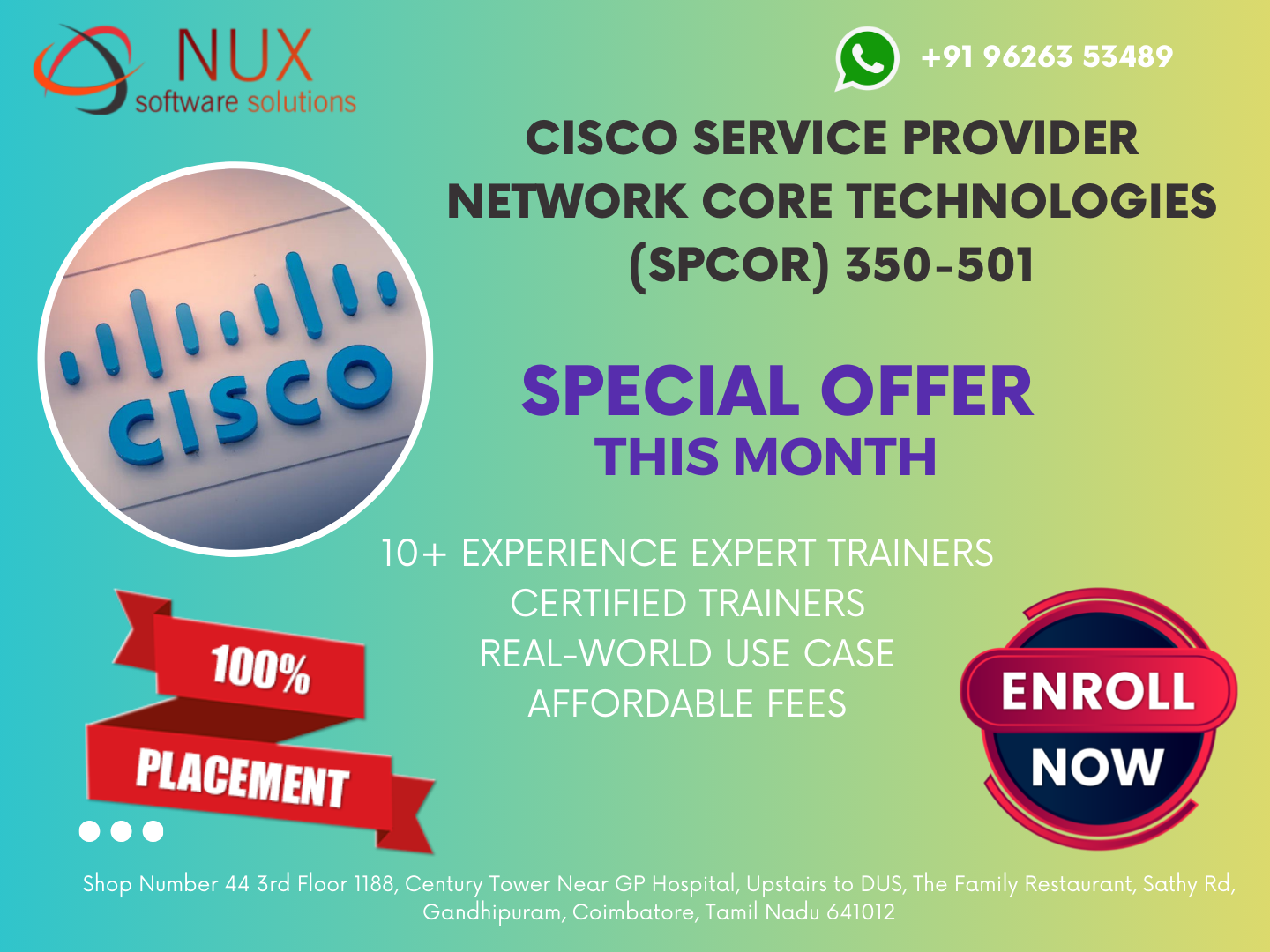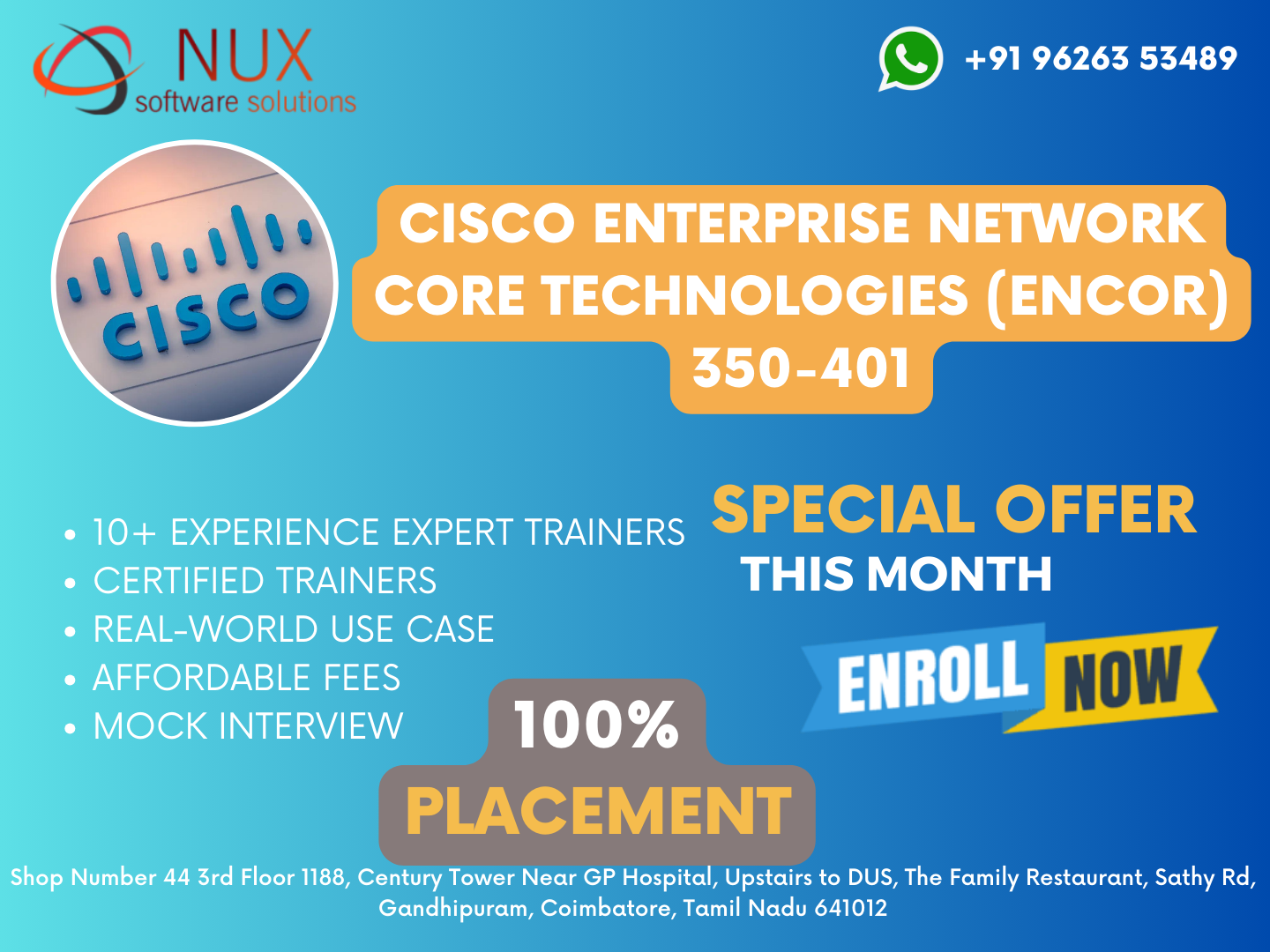Cisco Service Provider Network Core Technologies (SPCOR) 350-501


Dive into the world of Cisco Service Provider Network Core Technologies (SPCOR) 350-501 with our exceptional training courses at NuxSoftware Training & Certification Solutions in Coimbatore. Our advanced programs, led by industry experts, ensure hands-on experience and superior performance. Benefit from a cutting-edge training center ideal for professionals, individuals, corporate entities, live project training, and industrial training. Explore our well-managed labs with 24/7 accessibility, guided by international expert trainers with real-time industry experience. Elevate your skills, witness 100% career growth, and experience cost-effective training programs tailored to your needs. Flexibility is our commitment to your success.
We have placed above 500 registered companies and 10000+ students and professionals, all are working in the reputed positions.
Course Syllabus
Cisco Service Provider Network Core Technologies (SPCOR) 350-501 Syllabus
Architecture - 15%
1. Describe service provider architectures
- Core architectures (Metro Ethernet, MPLS, unified MPLS, SR), Transport technologies (Optical, xDSL, DOCSIS, TDM, and xPON), Mobility (packet core, RAN xhaul transport for 4G and 5G)
2. Describe Cisco network software architecture
- IOS, IOS XE, IOS XR
3. Describe service provider virtualization
- NFV infrastructure, VNF workloads, OpenStack
4. Describe QoS architecture
- MPLS QOS models (Pipe, Short Pipe, and Uniform), MPLS TE QoS (MAM, RDM, CBTS, PBTS, and DS-TE), DiffServ and IntServ QoS models, Trust boundaries between enterprise and SP environments, IPv6 flow label
5. Configure and verify control plan security
- Control plane protection techniques (LPTS and CoPP), BGP-TTL security and protocol authentication, BGP prefix suppression, LDP security (authentication and label allocation filtering), BGP sec, BGP flowspec
6. Describe management plane security
- Traceback, AAA and TACACS, RestAPI security, DdoS
7. Implement data plane security
- uRPF, ACLs, RTBH
Networking - 30%
1. Implement IS-IS (IPv4 and IPv6)
- Route advertisement, Area addressing, Multitopology, Metrics
2. Implement OSPF (v2 and v3)
Neighbor adjacency, Route advertisement, Multiarea (addressing and types), Metrics
3. Describe BGP path selection algorithm
4. Implement BGP (v4 and v6 for IBGP and EBGP)
- Neighbors, Prefix advertisement, Address family, Path selection, Attributes, Redistribution
5. Implement routing policy language and route maps (BGP, OSPF, IS-IS)
6. Troubleshoot routing protocols
- Neighbor adjacency (IS-IS, OSPF, BGP), Route advertisement (IS-IS, OSPF, BGP)
7. Describe IPv6 transition (NAT44, NAT64, 6RD, MAP, and DS Lite)
8. Implement high availability
- NSF / graceful restart, NSR, BFD, Link aggregation
MPLS and Segment Routing - 20%
1. Implement MPLS
- LDP sync, LDP session protection, LDP neighbors, Unified MPLS, MPLS OAM
2. Describe traffic engineering
- ISIS and OSPF extensions, RSVP functionality, FRR
3. Describe segment routing
- Segment types, IGP control plane, Segment routing traffic engineering, TI-LFa, PCE-PCC architectures
Services - 20%
1. Describe VPN services
- EVPN, Inter-AS VPN, CSC, mVPN
2. Configure L2VPN and Carrier Ethernet
- Ethernet services (E-Line, E-Tree, E-Access, E-LAN), IEEE 802.1ad, IEEE 802.1ah, and ITU G.8032, Ethernet OAM, VLAN tag manipulation
3. Configure L3VPN
- Intra-AS VPN, Shared services (extranet and Internet)
4. Implement multicast services
- PIM (PIM-SM, PIM-SSM, and PIM-BIDIR), IGMP v1/v2/v3 and MLD
5. Implement QoS services
- Classification and marking, Congestion avoidance, traffic policing, and shapil
Automation and Assurance - 15%
1. Describe the programmable APIs used to include Cisco devices in network automation
2. Interpret an external script to configure a Cisco device using a REST API
3. Describe the role of Network Services Orchestration (NSO)
4. Describe the high-level principles and benefits of a data modeling language, such as YANG
5. Compare agent vs. agentless configuration management
tools, such as Chef, Puppet, Ansible, and SaltStack
6. Describe data analytics and model-driven telemetry in service provider
7. Configure dial-in/out telemetry streams using gRPC
8. Configure and verify NetFlow/IPFIX
9. Configure and verify NETCONF and RESTCONF
10. Configure and verify SNMP (v2c/v3)


